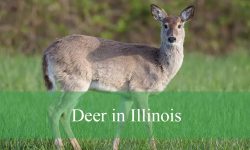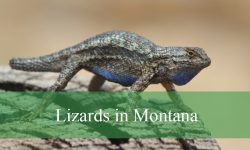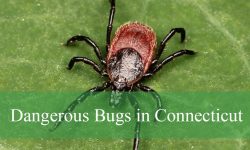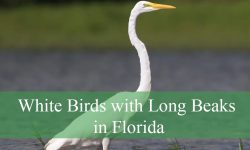Georgia is home to a fascinating variety of owls, ranging from tiny screech-owls to the majestic Great Horned Owl. Each species has unique calls, behaviors, and habitats, offering birdwatchers endless opportunities for observation.
These nocturnal hunters occupy forests, wetlands, farmlands, and even urban areas across the state. Their elusive nature and exceptional camouflage make spotting them a rewarding experience for enthusiasts and photographers alike.
From year-round residents like the Barred Owl to rare winter visitors such as the Snowy Owl, Georgia’s owls provide a glimpse into the rich biodiversity of the region. Learning to identify their calls and habitats enhances every nighttime adventure.
Different Types of Owls Found in Georgia
Eastern Screech-Owl (Megascops asio)
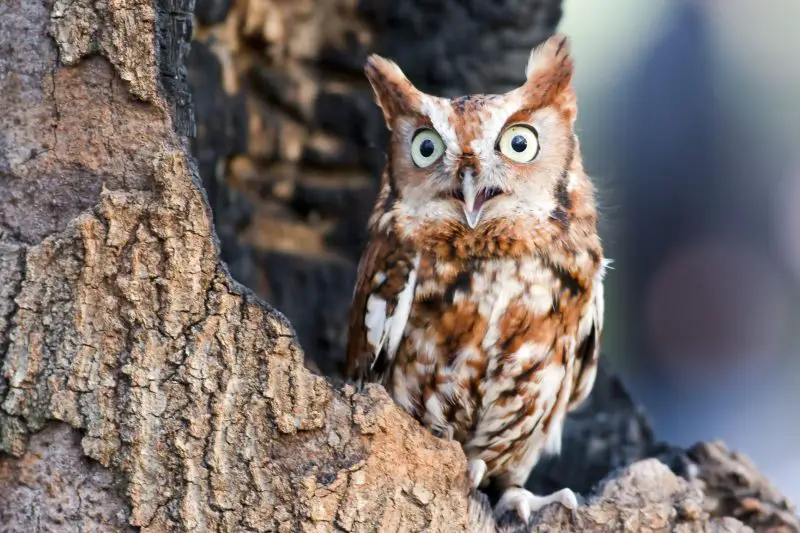
The Eastern Screech-Owl is a small, secretive owl widely distributed across Georgia, ranging from urban neighborhoods to deep forests. Adults measure around 6–10 inches in length and weigh roughly 4–8 ounces. Their compact bodies and ear tufts make them easily distinguishable, while their gray and reddish-brown color morphs provide exceptional camouflage against tree bark. These owls are masters of blending into their surroundings, often roosting in dense foliage during daylight hours.
Eastern Screech-Owls are cavity nesters, preferring natural tree holes, old woodpecker nests, or nest boxes in residential areas. They hunt primarily at night, preying on insects, small mammals such as mice and voles, and occasionally small birds or amphibians. Their hunting strategy involves perching quietly and swooping down silently to capture prey, using their keen eyesight and acute hearing to locate food in low-light conditions.
This species is particularly known for its vocal repertoire. Their signature trilling or whinnying calls are variable in pitch and duration and serve multiple purposes, including territory defense and mate communication. These calls are most prominent during breeding season, from late winter through spring, and are often the first indication of their presence for nocturnal birdwatchers.
The best way to observe Eastern Screech-Owls in Georgia is during early evening or pre-dawn hours, particularly in areas with mature trees and quiet surroundings. Listening for their distinctive calls in wooded suburbs or forest edges increases chances of sighting them, as these owls are elusive and rarely seen during daylight.
Great Horned Owl (Bubo virginianus)
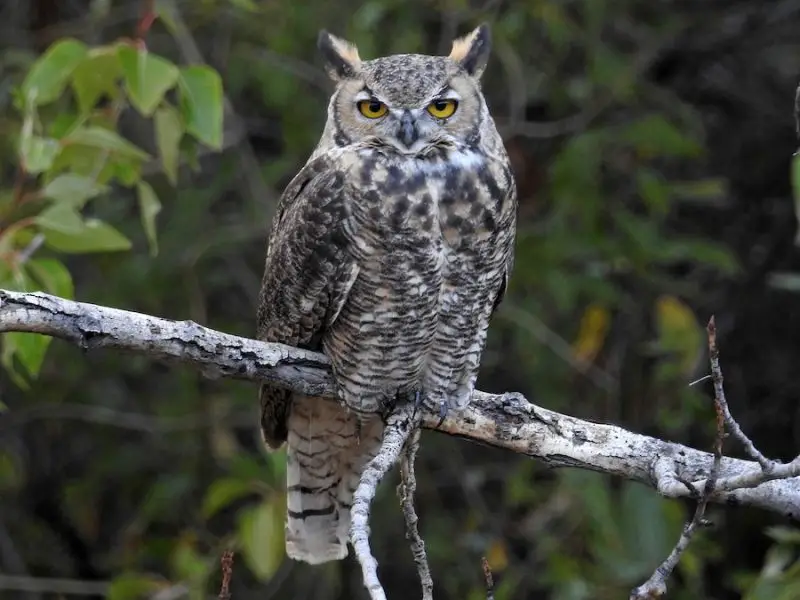
The Great Horned Owl is one of the largest and most powerful raptors in Georgia, measuring 18–25 inches in length with a wingspan of 3.3–4.8 feet. Its prominent ear tufts, yellow eyes, and mottled brown and gray plumage make it highly recognizable. This species’ size and strength allow it to hunt a wide variety of prey, from small mammals and birds to reptiles and even skunks, making it one of Georgia’s top nocturnal predators.
Great Horned Owls are highly adaptable and occupy a range of habitats, including forests, swamps, grasslands, and even urban areas. They are opportunistic hunters, typically ambushing prey from perches or performing silent, low glides over open areas. Their remarkable night vision and acute hearing allow them to detect prey movements even under dense vegetation or low-light conditions.
Nesting behavior involves utilizing abandoned nests of other large birds, tree cavities, or cliff ledges. Great Horned Owls are fiercely territorial, with pairs often occupying the same territory year-round. Their deep, resonant hoots are commonly heard in winter and early spring, functioning to establish territory and attract mates.
The ideal time to observe Great Horned Owls in Georgia is during the winter months when they are more vocal and active. Forest edges, wetlands, and open fields are prime locations, and birdwatchers often have better success spotting them at dusk or dawn when they begin their hunting activities.
Barred Owl (Strix varia)
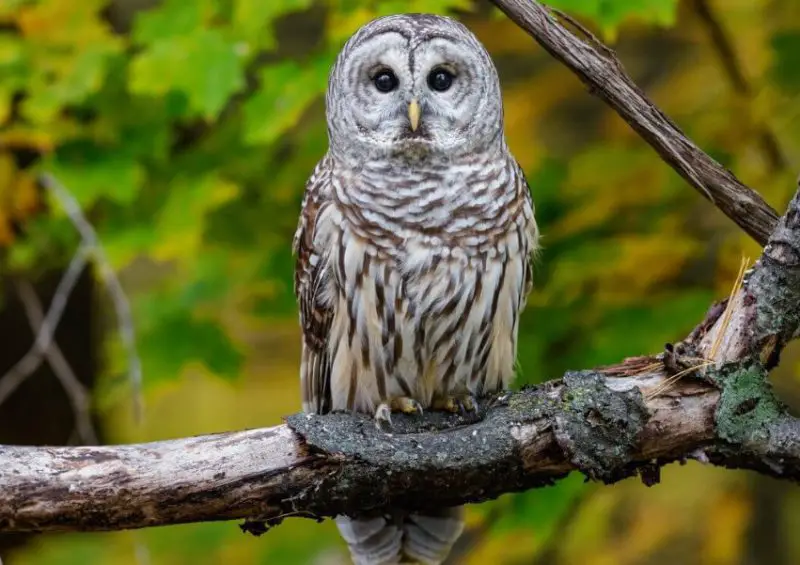
Barred Owls are medium-to-large owls with a round head, dark eyes, and no ear tufts. Adult Barred Owls measure 16–25 inches in length and have a wingspan of about 3.5–4 feet. Their brown-and-white barred plumage allows them to remain almost invisible among trees, particularly in Georgia’s dense hardwood forests and swampy bottomlands. They are one of the most vocal owl species, famous for the “Who cooks for you? Who cooks for you all?” call.
These owls are highly dependent on forested wetlands, riparian areas, and mature forests for both hunting and nesting. Their diet consists mainly of small mammals, such as squirrels, mice, and rabbits, but they will also take amphibians, reptiles, and birds when available. Barred Owls hunt mostly at night but may be active during twilight, using stealth and patience to ambush prey.
Barred Owls are non-migratory and usually remain in the same territory year-round. Nesting typically occurs in tree cavities, abandoned nests of other raptors, or natural hollows. They are monogamous and maintain strong pair bonds, raising 2–4 young per breeding season, with both parents contributing to feeding and protection.
The best time to observe Barred Owls in Georgia is from late winter to early spring when their territorial calls are most frequent. Walking quietly along streams or forest edges at dusk increases the likelihood of sightings, and using playback calls can sometimes elicit a response from nearby owls.
Barn Owl (Tyto alba)
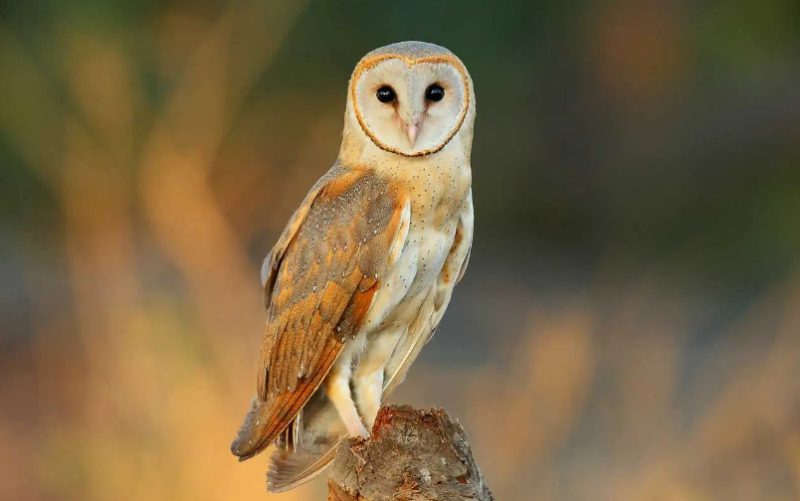
Barn Owls are medium-sized owls with a distinctive heart-shaped facial disk, pale underparts, and golden-buff upperparts. Adults measure 12–16 inches in length with a wingspan of 3–3.5 feet. Their ghostly appearance makes them stand out, especially when flying silently over open fields or pastures in Georgia during dusk and night.
Specialized hunters, Barn Owls primarily feed on small mammals like voles, mice, and shrews. They rely on exceptional hearing and low-light vision to locate prey, often hunting in open areas where grass or crops conceal rodents. Their silent flight allows them to approach prey without warning, and they can consume significant amounts of rodents nightly, making them beneficial for agricultural areas.
Barn Owls are cavity nesters, preferring abandoned buildings, barns, tree cavities, or nest boxes. Unlike many other owls, they are less vocal, producing hissing, screeching, and snoring sounds mostly during the breeding season. They typically lay 4–7 eggs, and both parents play a role in feeding and protecting the chicks until they fledge.
The best chance to observe Barn Owls in Georgia is at night in open farmlands, grasslands, or along forest edges. Late winter through early summer is the optimal period, coinciding with the breeding season and high hunting activity. Observers should remain quiet and use a flashlight sparingly to avoid disturbing these sensitive owls.
Northern Saw-whet Owl (Aegolius acadicus)
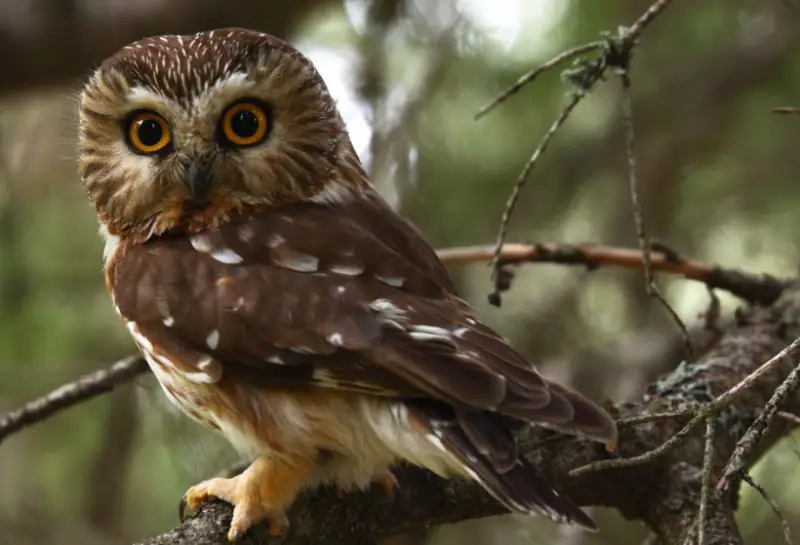
Northern Saw-whet Owls are tiny, compact owls measuring only 7–8 inches in length with a wingspan of about 16–20 inches. They have large, round heads, bright yellow eyes, and streaked brown-and-white plumage that provides excellent camouflage among dense evergreen and mixed forests in Georgia. Their small size allows them to navigate thick vegetation while hunting or roosting.
These owls feed mainly on small mammals like mice and voles, capturing prey silently from low perches. They are strictly nocturnal and are known for their soft, high-pitched whistling calls. Despite their small stature, they are skilled predators and can consume up to 50% of their body weight in a single night.
Northern Saw-whets usually nest in natural cavities or abandoned woodpecker holes. Their reproductive success depends on prey availability, with clutches typically containing 4–7 eggs. While migratory in northern regions, some individuals remain in southern states like Georgia year-round, especially in coniferous forests.
The optimal time to observe Northern Saw-whet Owls in Georgia is during fall migration and winter months. Dense forests, especially coniferous groves and mixed woodlands, provide the best habitat. Listening for their soft whistling calls at night or using mist nets for banding studies are the primary ways ornithologists locate them.
Short-eared Owl (Asio flammeus)

The Short-eared Owl is a medium-sized owl with a round face, small ear tufts that are often hard to see, and striking yellow eyes. Adults typically measure 13–17 inches in length with a wingspan of 33–43 inches. Their mottled brown and buff plumage provides excellent camouflage in grassy fields and open landscapes, where they spend much of their time hunting during both day and night.
This species primarily feeds on small mammals such as voles, mice, and shrews. Unlike many other owls, Short-eared Owls are often seen hunting in daylight, especially in late afternoon or early evening, gliding low over fields with slow, deliberate wingbeats. They rely on keen eyesight and sensitive hearing to detect movement in the grass.
Short-eared Owls nest on the ground, often in dense grasslands or marshy meadows. They create shallow depressions lined with grass for their eggs, which typically number 4–7 per clutch. Their ground nests make them vulnerable to predators, so they rely on camouflage and stealth to protect their young.
The best time to observe Short-eared Owls in Georgia is during winter when they migrate south from northern breeding grounds. Open fields, coastal marshes, and grasslands provide optimal viewing locations. Observers are most likely to see them at dawn or dusk, when they are actively hunting.
Long-eared Owl (Asio otus)
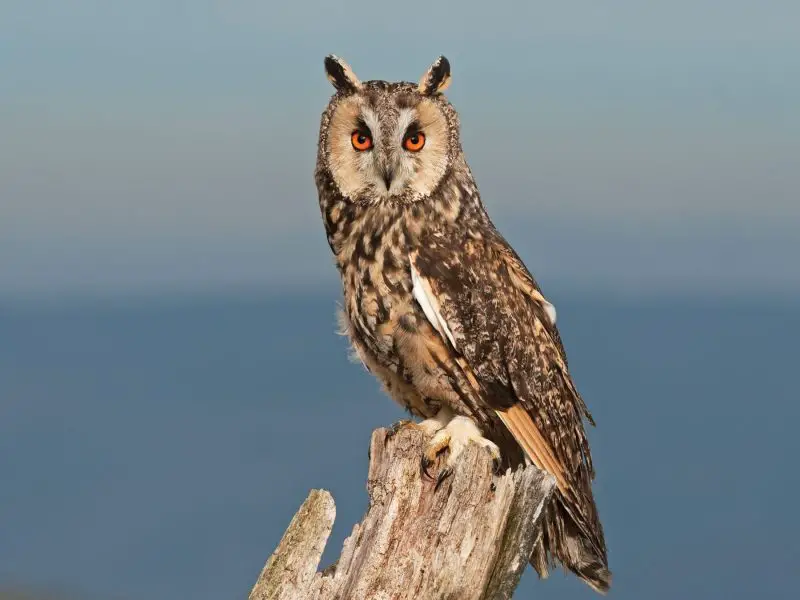
The Long-eared Owl is a medium-sized owl distinguished by its long ear tufts, orange eyes, and brown-and-gray streaked plumage. Adults measure 13–16 inches in length with a wingspan of 35–39 inches. Their cryptic coloration helps them remain hidden among trees, making them one of Georgia’s more elusive owl species.
Long-eared Owls primarily hunt small mammals such as mice, voles, and shrews. They are nocturnal hunters, using their excellent night vision and acute hearing to detect prey from perches within forested areas. They often perch quietly in dense foliage before swooping down silently on unsuspecting prey.
This species typically nests in loose colonies, often using abandoned nests of crows or hawks in dense forests or thickets. A clutch usually consists of 4–6 eggs, with both parents sharing in feeding and protection. Long-eared Owls are migratory in northern regions but may remain in Georgia year-round, depending on food availability.
The optimal time to observe Long-eared Owls in Georgia is during winter, especially in mature forests, pine plantations, and areas near open fields. Listening for their low, hooting calls at night increases the likelihood of spotting one in dense cover.
Snowy Owl (Bubo scandiacus)
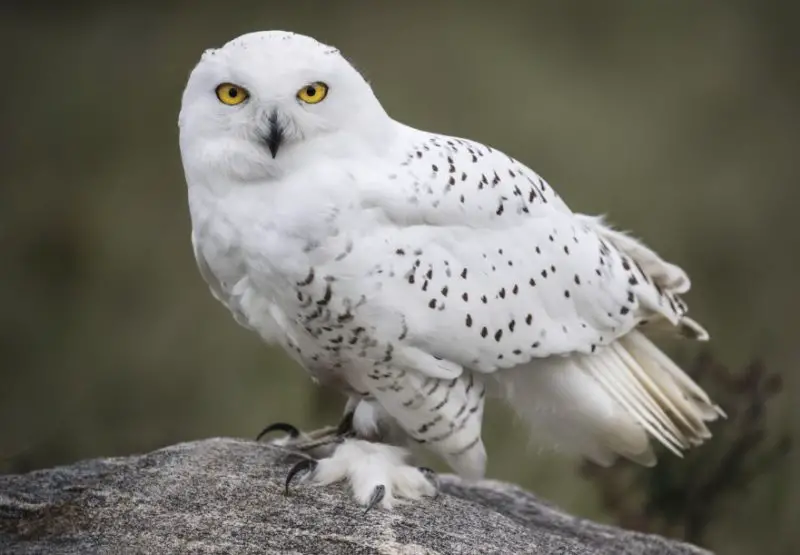
Snowy Owls are large, striking white owls with black or brown markings. Adults can measure 20–28 inches in length with a wingspan of 49–59 inches. Their snowy plumage provides camouflage in their Arctic breeding grounds, but in Georgia, they are rare winter visitors, often appearing in open fields and coastal areas.
Snowy Owls primarily hunt small mammals such as lemmings in their native habitat, but in Georgia, they rely on voles, mice, and occasionally birds. They hunt mostly during the day, which is unusual for owls, allowing observers to spot them more easily. Their hunting technique involves sitting on elevated perches or flying low over open terrain to locate prey.
These owls do not breed in Georgia, as they are migratory from the far north. They are often seen alone or in small groups during irruptive winters when food scarcity pushes them south. Their large size, snowy plumage, and calm demeanor make them a spectacular sight for birdwatchers.
The best time to see Snowy Owls in Georgia is during winter, especially in large open fields, airports, and coastal barrier islands. Observers often find them perched prominently, scanning the ground for prey.
Boreal Owl (Aegolius funereus)
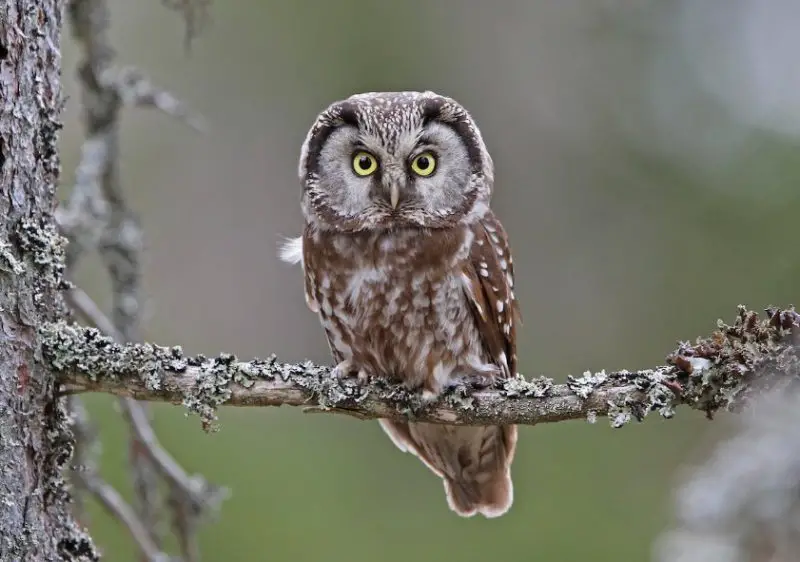
The Boreal Owl is a small, elusive owl with a round head, yellow eyes, and fine streaking on the chest. Adults measure 7–9 inches in length with a wingspan of 16–20 inches. This species is extremely rare in Georgia, usually appearing only as an accidental vagrant during migration or severe winter conditions.
Boreal Owls hunt primarily at night, feeding on small mammals and occasionally birds. Their hunting strategy involves perching quietly in dense forests and swooping down silently on unsuspecting prey. Due to their secretive behavior, they are rarely observed, even in areas with suitable habitat.
Nesting typically occurs in tree cavities, often abandoned woodpecker holes in coniferous forests. Clutches generally contain 3–7 eggs, and both parents care for the young. They are primarily residents of boreal forests in northern regions but may wander south irregularly during harsh winters.
The best chance to observe Boreal Owls in Georgia is extremely limited and mostly during rare winter irruptions in northern forested areas. Because of their rarity, spotting one is considered a major highlight for local birders.
Western Screech-Owl (Megascops kennicottii)
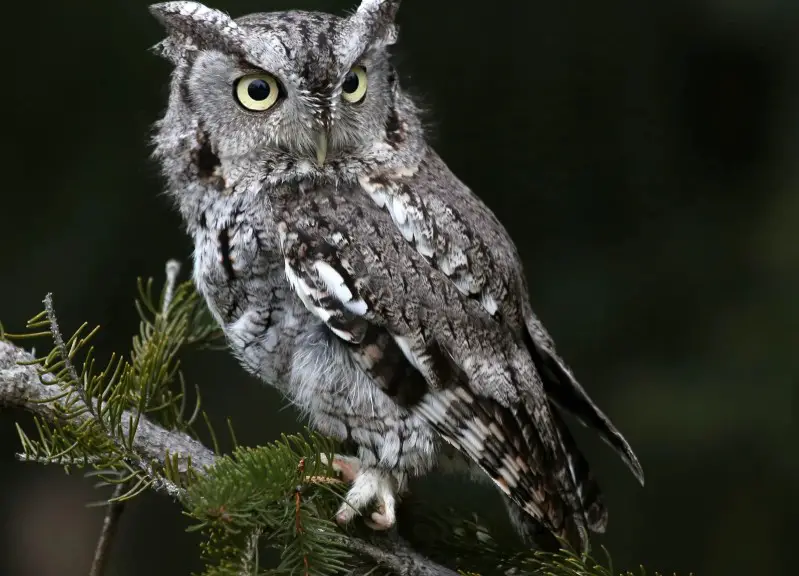
The Western Screech-Owl is a small owl with ear tufts, mottled gray or brown plumage, and yellow eyes. Adults measure 7–10 inches in length with a wingspan of 18–24 inches. While native to western North America, a few individuals have been recorded as vagrants in Georgia, making sightings exceptionally rare.
These owls are nocturnal hunters, preying on insects, small mammals, and birds. They typically hunt from perches in wooded areas, using stealth and sudden flight to capture prey. Their calls consist of short trills and whinnies, similar to the Eastern Screech-Owl, but are often higher-pitched.
Western Screech-Owls nest in tree cavities or old woodpecker holes. Their reproductive behavior mirrors that of the Eastern Screech-Owl, with a clutch of 3–6 eggs and parental care shared between both adults. They are highly secretive and difficult to locate in areas outside their normal range.
The best opportunity to observe a Western Screech-Owl in Georgia is during rare vagrant occurrences in mature forests. Birders are advised to listen for their distinctive trills at night and to scan cavities in old trees for signs of roosting.
Best Time and Places to Observe Owls in Georgia
Owls in Georgia can be observed year-round, but the best times vary depending on species and season. Nocturnal species such as Eastern Screech-Owl, Great Horned Owl, and Barred Owl are most active at dusk and during the night, while some owls, like Short-eared and Snowy Owls, may hunt during daylight hours, especially in open fields during winter. Early evening and pre-dawn hours offer the highest chances of sightings for most species.
Habitats play a key role in spotting these birds. Barred Owls prefer dense, mature forests near rivers or swamps, while Eastern Screech-Owls thrive in suburban areas with large trees. Barn Owls and Short-eared Owls are commonly found in open farmlands and grassy fields. Winter visitors like Snowy Owls often appear in coastal regions, airports, and wide-open landscapes. Using owl calls at dusk or quietly scanning perches in suitable habitats increases the likelihood of sightings.
Seasonal migration also affects observation opportunities. Northern Saw-whet Owls are more likely to be found during fall migration and winter months, whereas Great Horned Owls and Barred Owls are largely resident and can be seen year-round. Birdwatchers should focus on quiet, low-light conditions and avoid disturbing roosting sites to improve both success and safety.
FAQs About Owls in Georgia
What owl species are most common in Georgia?
The most commonly observed owls include Eastern Screech-Owl, Great Horned Owl, Barred Owl, Barn Owl, and Northern Saw-whet Owl. Other species like Snowy Owl or Boreal Owl are rare or occasional visitors.
When is the best time to hear owl calls?
Owl calls are most prominent at dusk and night, especially during breeding season from late winter to early spring. Some species, like Short-eared and Snowy Owls, may vocalize during the day in winter.
Where should I go to see owls in Georgia?
Dense forests, wetlands, and riversides are ideal for Barred Owls. Suburban neighborhoods with mature trees are good for Eastern Screech-Owls. Open fields, farmland, and coastal areas are the best locations for Barn, Short-eared, and Snowy Owls.
Are owls dangerous to humans?
No, owls are generally not dangerous. They may defend nests if threatened, but they avoid humans and are mostly nocturnal hunters of small animals.
How can I attract owls for observation?
Providing nesting boxes in safe, quiet areas and maintaining habitats rich in prey like rodents can attract owls. Avoid direct disturbance, and listening for calls at night is a non-intrusive way to locate them.

